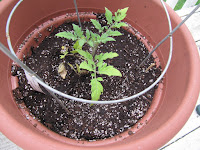Ok...raise your hand if you are a master gardener? Not to many. How about if you are really good at growing weeds? Ok that looks like everybody! Well I have good news for you, herbs are weeds! YOU CAN GROW THEM.
Here are the herbs and tomatoes I am growing this season. I will chronicle with pictures and recipes as the days go by!
Feel free to contribute any recipes. I will add them to my newest cookbook.
OK here are the newest goodies just planted yesterday May 15th!
 Tarragon
Tarragon
I grow
Tarragon for its aromatic leaves. It flavors vinegar and a variety of recipes. Tarragon herb is a native to dry, rocky areas of Northwest U.S., Russia, and Asia. It thrives in poor, dry, funkey soils in areas with warm days and nights. .
Tarragon grows to 2 to 5 feet. The plant has aromatic leaves that are thin and blade-like.. It produces droopy flowers in mid summer.
How to Grow Tarragon:Tarragon thrives in dry conditions and poor soils. They prefer dry, rocky or gravel or sandy soil. They need full sun. The plant needs a warm, dry weather, day and night.
It is also grown from seed, but I get a plant all ready started. Seeds can be sown directly in the garden.
Established plants will grow well with little care. Keep the soil slightly dry.
 Oregano
Oregano Oregano is one of the most popular herbs in the kitchen. Oregano is a popular herb in Italian and Mediterranean dishes. Oregano plants are closely related to Marjoram, and are members of the Mint family. They originated in Europe and Central Asia.
Oregano plants are easy to grow. They thrive in dry, arid regions. Plants grow two to four feet.
I grow Oregano in containers on my decks.
How to Grow Oregano:Oregano is easy no brainer to grow. Grow Oregano plants in full sun. Plants do well in average, well draining soils.
Water plants only during dry periods, once every week or two.
Pick flower buds as soon as they appear. The leaves turn bitter after flowers bloom.
Harvest leaves at any time after the plant has produced a few dozen leaves. Pick the young, tender leaves, as they are best for flavor. Depending on who's comming over for dinner you can decide to wash the leafs or not.
Pick them in the morning when the oils are strongest. Spread leaves out to dry in a cool and ventilated area. Leaves can also be put in the freezer for later use.
 Stevia
Steviaf you've ever tasted stevia, you know it's extremely sweet. In fact, this remarkable noncaloric herb, native to Paraguay, has been used as a sweetener and flavor enhancer for centuries. But this innocuous-looking plant has also been a focal point of intrigue in the United States in recent years because of actions by the U.S. Food and Drug Administration.
The subject of searches and seizures, trade complaints and embargoes on importation, stevia has been handled at times by the FDA as if it were an illegal drug.
Since the passage of the Dietary Supplement Health and Education Act (DSHEA), stevia can be sold legally in the United States, but only as a "dietary supplement." Even so, it can be found in many forms in most health-food stores, and is also incorporated into drinks, teas and other items (all labeled as "dietary supplements"). It cannot, however, be called a "sweetener" or even referred to as "sweet." To do so would render the product "adulterated," according to the FDA, and make it again subject to seizure.
 Cilantro
CilantroI love Cilantro. Cilantro is native to Asia and the Mediterranean regions. With parsley like leaves, it produces small, white flowers. Seeds have a pleasant odor when ripe, and are sweet tasting. Cilantro plants grow up to three feet tall.
Want to grow two herbs in one plant? The plant is called Cilantro. The seeds are called Coriander. It is also called Chinese Parsley...yes, it's a member of the Parsley family.
How to Grow Cilantro:Grow Cilantro full sun to partial shade. They will do well in most soil. Soil should be well draining. Plants are tolerant of dry soil conditions.
Coriander are grown from seed. Directly sow seeds into your garden after all danger of frost. Cover lightly with garden soil. Or, start seedlings indoors, 2-4 weeks prior to the last frost in your area.
Space seedlings or thin plants to 6" apart, in rows two feet apart. They will tolerate a little crowding.
Water plants during dry periods, once or twice per week.
Uses for Cilantro and Coriander:
Cilantro is used in wide variety of ethnic recipes, including Mexican, Tex-Mex, Spanish, and Asian cuisines.
Use the fresh leaves chopped or as garnish. It is a key ingredient in salsa. It's also used in soups, seafood, and main dishes.
Seeds are an ingredient in curry, Seed oil is used to flavor liqueurs, candies and sauces. You can also use Coriander seeds in breads, cakes, and main dishes.
 Basil
Basil If you tend to a herb garden, you almost certainly grow Basil. Basil herb is one of the most popular herbs in both the garden and the kitchen. Basil herb plants are easy to grow.Basil
Basil plants are attractive in the garden. You can grow them in the herb garden, in windowsill planters, or containers on your patio or deck. They are very popular grown indoors during winter months. They do need a sunny window, but are otherwise easy to grow indoors.
There are many varieties to choose from. The most common varieties are Sweet Basil and Genovese Basil. Some varieties have flavors like anise, cinnamon, lemon and licorice.
 Roma TomatoesWhat is a roma tomato?
Roma TomatoesWhat is a roma tomato?A roma tomato is a paste tomato. Paste tomatoes, like roma tomatoes, generally have a thicker fruit wall, fewer seeds and a denser but more grainy flesh. Roma tomatoes tend to be oblong in shape and heavy for their size. The also tend to be more firm than a non-roma or paste tomato.
How to grow roma tomatoesPrepare the soil of your tomato bed by adding compost or a slow release fertilizer. Once you plant your roma tomato plants, water them at least once a week. Once your roma tomato plants are 6″ – 12″ high, start staking the roma tomatoes up off the ground.
Romas do tend to be a little easier to grow than other tomatoes due to the fact than many are fusarium and verticillium wilt resistant. While these diseases can kill other tomatoes, many times roma tomato plants can withstand the disease.
 Cherry TomatoesHow to Grow Cherry Tomatoes
Cherry TomatoesHow to Grow Cherry TomatoesOne of the best tips on growing cherry tomatoes I ever heard is to put limestone in the bottom of each of the holes before putting the plants into the ground. This will prevent blossom end rot. Planting cherry tomatoes should be done after the plants are six to ten inches tall. If you do it before this time, your tomato plants may die. :(
You need to make sure when growing cherry tomato plants that you fertilize the pot. You can use a starter fertilizer in the beginning. This gives the plants a good start. After that you can side dress the plants as necessary.
Another one of the better tips on growing cherry tomatoes I have ever heard is to pinch off the suckers. What these are is new growth that appears where the branches meet the stalk or “V” off. These little suckers will rob the plant of nutrients. Pinching them off makes sure your growing cherry tomato plants will continue to flourish.
Another one of the better tips on growing cherry tomatoes is to tie the plants to a stake so they stay standing. Once your plant is full of tomatoes, it will get heavy. When planting cherry tomatoes, make an allowance for the space needed for each of the full grown plants along with stakes and ties. Further, keeping the growing cherry tomatoes off the ground prevents worms from eating them.
The grow time of cherry tomatoes is about a couple of months. This can be quicker or slower depending on the weather. You want to watch the tomatoes for signs of ripening such as turning red. When they are red, you can pick them. The riper they are, the easier they are to pull off the plant. Simply pick and enjoy! The plants should produce for quite a period throughout the summer.
 Heirloom from Italy
Heirloom from ItalyIt's name says it. A real classic heirloom from Italy. Heirloom tomato seeds produce tomato plants that yield an load of 12-16 oz., beautiful, red, meaty, fat, slightly pear-shaped, tomatoes that enjoy an abundance of rich, complex, sweet flavors that are well-balanced with good acidity, so I'v been told. This will the first year to try this type to fruit.
 Chicken and Spinach Salad of LOVE
Chicken and Spinach Salad of LOVE























